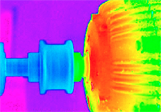Even under normal operating conditions, all machinery generates heat. However, excessive heat can be generated from friction caused by inadequate lubrication, misuse, and normal wear.
Because temperature is one of the first observable parameters to indicate the health of a component, Infrared Thermography is an excellent choice for monitoring the condition of your mechanical equipment.
How is Infrared used in determining the health of mechanical equipment?
Infrared Thermography can be used to identify the amount of thermal energy (heat) being generated by a component when operating under normal load. A thermal image is captured showing the temperature distribution under normal conditions.
Once a normal thermal signature (baseline) is obtained and understood, any deviation from the normal thermal signature will then provide evidence that a potential problem is developing.
This highly-effective, non-contact, non-destructive testing method, can be used to monitor the condition of bearings, gears, shafts, couplings, pulleys, conveyers, vacuum pumps, clutches, and much more.

Our Client Are:
Residential
✓ Home Owner
✓ Real Estate Agent
✓ Insurance
✓ Inspector
✓ Appraisal
✓ Contractor
✓ Engineer
✓ Architect
Commercial
✓ Home, office, building, or facility owners / managers
✓ Schools, Hospitals, Offices, Restaurants
✓ Building and home Inspectors
✓ Real Estate Agents
✓ Insurance companies
✓ Appraisal
✓ Contractor
✓ Engineers and engineering firms
✓ Architect
WHY INFRARED?
Reasons To Use Infrared Scanning:
✓ Non-destructive Testing
✓ Very good results without changing the existing installations
✓ Low price for potential high saving
✓ Home air or water leak detection
✓ Find precise location of water leak
✓ Home moisture detection
✓ Leak and moisture detection in flat roofing
✓ Areas of heat loss within homes or buildings
✓ Insufficient insulation and voids
✓ Radiant floor inspection
✓ Abnormal heating of mechanical systems
✓ Abnormal heating of electrical components
✓ Reduce heat and AC cost
✓ Ensure proper functioning of electrical and mechanical equipment
✓ Reduce risk of fire
